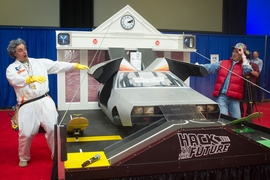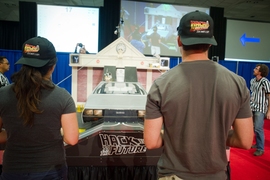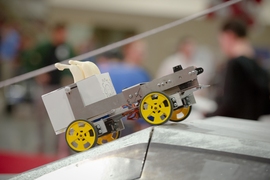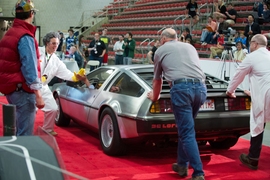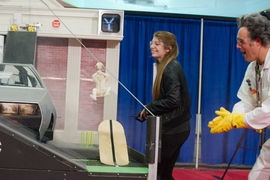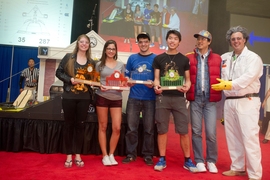The future, as defined in the first sequel to 1985’s classic time-travel saga “Back to the Future,” is this year: 2015.
So, appropriately enough, that movie was selected as the theme for this year’s version of the annual competition that marks the end of the MIT mechanical engineering course 2.007 (Design and Manufacturing). The popular head-to-head competition between student-built robots is an MIT tradition that goes back even farther than the three-decade old film — all the way back to 1970.
Last evening’s 2.007 finals were open to the public, and attracted hundreds of cheering spectators of all ages. The competition, as always, featured many a suspenseful moment as students competed side by side in controlling the robots they had spent a semester designing, building, and testing. Students used a wide variety of clever approaches to score points on a complex field built in the shape of a DeLorean car and clock tower — both of which figured prominently in the 1985 movie.
But, as is often the case in 2.007 competitions, while some unusual designs scored astonishingly high point totals, it was ultimately a relatively slow — but efficient and reliable — design that made its way through the single-elimination tournament to emerge as the winner.
That robot, called “Rafiki,” was the design of Allison Edwards, a sophomore majoring in mechanical engineering. While other robots scored much higher point totals in certain matchups, none produced such consistent performance.
Edwards, beaming after her win, paid tribute to her classmates, saying: “You build amazing robots. You should all be very proud.”
“The last two years in a row, very steady and reliable designs have won,” said Sangbae Kim, an assistant professor of mechanical engineering and one of the class’s instructors. In fact, the competition’s final matchup featured two very similar such designs, which proceeded nearly side by side through much of the match.
Both the winning robot and the close runner-up, built by junior mechanical engineering major Yamile Pariente, were single robots; many other students built two or more robots, as allowed by the competition’s rules, to carry out different tasks. Edwards’ and Pariente’s designs climbed straight to the top level and attempted three different tasks there: dumping bananas into a bin labeled “flux capacitor,” to provide fuel for the time machine; stopping time, by pressing a big red button to stop the rapidly twirling hands on the clock tower, and saving Dr. Emmett Brown, a “Back to the Future” protagonist, by releasing a plastic figure to allow it to slide down a cable to the lowest level.
Other students tried very different point-scoring tactics, sometimes with results that seemed to stun even the course’s instructors — assistant professor of mechanical engineering Amos Winter (who dressed as Brown) and Kim (who dressed as the film’s other protagonist, time-traveling Marty McFly).
While the winning score in the final matchup between Edwards and Pariente was 287 points, the third- and fourth-place scores were 378 and 540; one student even managed to score 756 in one of the earlier rounds. “The best score ever! Amazing!” Winter exclaimed.
That high scorer, mechanical engineering junior Amado Antonini, used a robot called “Catfish” that focused on a single task: riding up and down a slanted cable from the starting box to the clock tower. It used one robot to lift a wheeled runner onto the cable and then release it; that runner then simply raced back and forth on the cable, racking up points for each round trip.
But Antonini’s clever device hit a snag, literally, in the semifinals when a dangling string (needed to meet the rules requiring robots to make contact with structures at the top and bottom) got tangled with the deploying robot.
A similar fate befell the fourth-place finisher, mechanical engineering sophomore Brian Yue, who used a very similar strategy with a cable-runner called “Shadowfeet” that was deployed by a stationary robot. It, too, got stuck right at the start in its semifinal match, after racking up impressively high scores in each previous round.
Others used entirely different approaches. One student made a robot intended to drive straight to the base of the clock tower and deploy a 5-foot scissor jack-like structure to dunk its payload into the receptacle at the top. Unfortunately, its angle was slightly off, and the bananas missed the flux capacitor, resulting in a score of 0.
Another student used a variation on the cable-running robots, adding a hook that could be lowered to pull up on the DeLorean parked below, opening its door. That maneuver, which would double a contestant’s score, was usually accomplished by other robots dedicated to that purpose, which approached from below the door and pushed up.
Many robots failed, despite their clever designs, when a slight misalignment caused them to tumble off the side of a ramp, flip over backward on a steep slope, or burn out a motor or strip gears while racing to score points — teaching students significant lessons about design, balance, torque, material properties, and the vagaries of luck.
“Most students think this is one of the most memorable classes they take,” Kim said: For many, it’s their first experience designing and building a functional machine.
One student named her robot “SSO,” for “statistically significant other” — a joking reference to friendly teasing about the amount of time she spent working on the robot. As another student said in a video shown at the match, “This is exactly the stuff I want to be doing for the rest of my life.”
